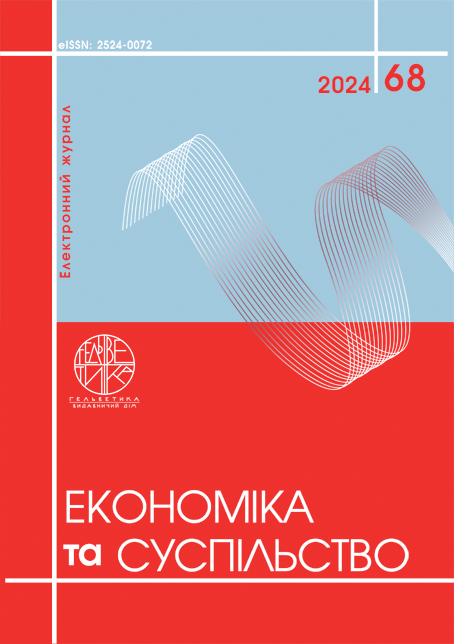RESEARCH OF THE IMPACT OF INTERNATIONAL LABOR MIGRATION PROCESSES ON THE ECONOMY OF DEVELOPED COUNTRIES
Abstract
The article explores the influence of international labor migration on the economies of developed countries, highlighting key factors that drive migration, including unemployment and economic crises in less developed countries, demographic shifts, and established cultural and familial ties. Migration has become a crucial element of globalization, reshaping labor markets and affecting wages, productivity, and unemployment rates in host countries. Germany and the UK serve as prominent examples, where international labor migration helps mitigate workforce shortages, support economic growth, and strengthen social systems, although these countries also face integration challenges. Germany attracts migrants with economic stability, competitive wages, and a high quality of life. The influx of foreign workers has positive economic impacts, boosting GDP, filling labor gaps, and enhancing innovation. Likewise, the UK benefits from an expanded workforce that meets demand in critical sectors and drives economic productivity, but the need for effective integration policies remains crucial to managing social impacts. The article also examines recent trends in Ukrainian migration, driven by economic instability and the 2022 military conflict. Ukrainian migrants primarily settle in EU countries like Poland and Germany, drawn by proximity, migration agreements, and cultural similarities. The UK and Canada also see significant Ukrainian arrivals, supported by tailored programs like “Homes for Ukraine,” aimed at aiding their integration. However, this migration brings challenges for host countries in providing social services and resources for integration. Long-term impacts on Ukraine include demographic shifts and the loss of skilled professionals, which could hamper economic recovery. Migration remains essential for shaping the demographic, social, and economic landscapes of developed countries and Ukraine alike. The article suggests that Ukraine should develop strategies to support citizens abroad, encourage eventual return, and create reintegration pathways to strengthen its post-stabilization economy.
References
Міжнародна трудова міграція: причини, тенденції та наслідки. URL: https://conf.ztu.edu.ua/wp-content/uploads/2019/01/161.pdf (дата звернення 20.10.2024)
Bundesagentur für Arbeit. (2022). “Der Arbeitsmarkt in Deutschland.” URL: https://www.arbeitsagentur.de (дата звернення 20.10.2024)
Federal Ministry of Labour and Social Affairs. (2022). “Labour Migration in Germany.” URL: https://www.bmas.de (дата звернення 18.10.2024)
Міжнародна організація з міграції. (2022). “Міграційні процеси в Європі.” URL: https://www.iom.int (дата звернення 24.10.2024)
Office for National Statistics. (2022). “Migration Statistics Quarterly Report.” URL: https://www.ons.gov.uk (дата звернення 16.10.2024)
UK Home Office. (2022). “New Points-Based Immigration System.” URL:https://www.gov.uk/government/organisations/home-office (дата звернення 24.10.2024)
Migration Observatory at the University of Oxford. (2022). “Migration and the UK Economy.” URL: https://migrationobservatory.ox.ac.uk (дата звернення 16.10.2024)
DW – “Germany to ease immigration law to attract skilled workers” (2023)
Fragomen Policy Insights – “The German Immigration Reform of 2023/2024”
BBC – The impact of immigration on the UK economy
Fragomen Policy Paper – UK immigration changes post-Brexit
United Nations High Commissioner for Refugees (UNHCR). (2023). “Ukraine Refugee Situation.” URL:https://www.unhcr.org (дата звернення 22.10.2024).
International Organization for Migration (2024). URL: https://www.iom.int (дата звернення 23.10.2024).
Національний банк України (2024). URL:https://bank.gov.ua (дата звернення 23.10.2024).
United Nations High Commissioner for Refugees (UNHCR). (2023). “Ukraine Refugee Situation.” URL: https://www.unhcr.org (дата звернення 22.10.2024).
European Migration Network (EMN). (2023). “Migration Trends and Policy Responses in Europe.” URL: https://ec.europa.eu (дата звернення 23.10.2024).
International Labor Migration: Causes, Trends, and Implications. URL: https://conf.ztu.edu.ua/wp-content/uploads/2019/01/161.pdf (accessed October 20, 2024).
Bundesagentur für Arbeit. (2022). “Der Arbeitsmarkt in Deutschland.” URL: https://www.arbeitsagentur.de (accessed October 20, 2024).
Federal Ministry of Labour and Social Affairs. (2022). “Labour Migration in Germany.” URL: https://www.bmas.de (accessed October 18, 2024).
International Organization for Migration. (2022). Migration Processes in Europe. URL: https://www.iom.int (accessed October 24, 2024).
Office for National Statistics. (2022). “Migration Statistics Quarterly Report.” URL: https://www.ons.gov.uk (accessed October 16, 2024).
UK Home Office. (2022). “New Points-Based Immigration System.” URL: https://www.gov.uk/government/organisations/home-office (accessed October 24, 2024)
Migration Observatory at the University of Oxford. (2022). “Migration and the UK Economy.” URL: https://migrationobservatory.ox.ac.uk (accessed October 16, 2024)
DW – “Germany to ease immigration law to attract skilled workers” (2023)
Fragomen Policy Insights – “The German Immigration Reform of 2023/2024”
BBC – The impact of immigration on the UK economy
Fragomen Policy Paper – UK immigration changes post-Brexit
United Nations High Commissioner for Refugees (UNHCR). (2023). “Ukraine Refugee Situation.” URL: https://www.unhcr.org (accessed October 22, 2024)
International Organization for Migration (2024). URL: https://www.iom.int (accessed October 23, 2024).
National Bank of Ukraine (2024). URL:https://bank.gov.ua (accessed October 23, 2024)
United Nations High Commissioner for Refugees (UNHCR). (2023). “Ukraine Refugee Situation.” URL: https://www.unhcr.org (accessed October 22, 2024)
European Migration Network (EMN). (2023). “Migration Trends and Policy Responses in Europe.” URL: https://ec.europa.eu (accessed October 23, 2024)

This work is licensed under a Creative Commons Attribution 4.0 International License.


